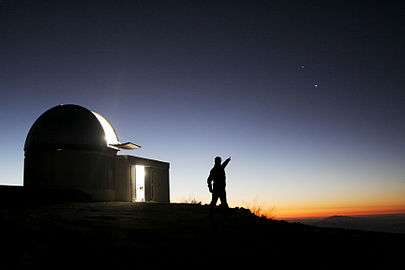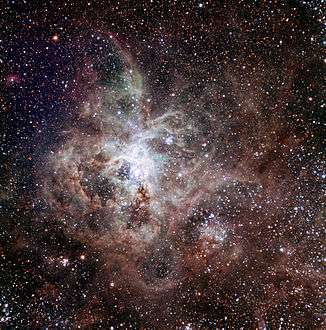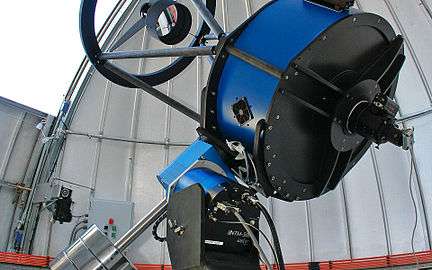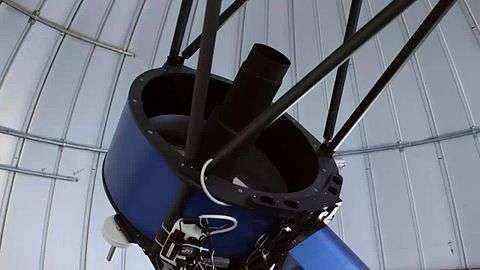TRAPPIST
 | |
| Coordinates | 29°15′18″S 70°44′20″W / 29.255°S 70.739°WCoordinates: 29°15′18″S 70°44′20″W / 29.255°S 70.739°W |
|---|---|
| Telescope style |
robotic telescope |
| Website |
www |
_by_TRAPPIST_on_2013-11-15.jpg)

The Transiting Planets and Planetesimals Small Telescope (TRAPPIST) is a Belgian optic robotic telescope, which came online in 2010. It is named in homage to the Trappist Order in the Belgian region.[1][2]
Situated high in the Chilean mountains at ESO's La Silla Observatory, it is actually controlled from Liege, Belgium, with some autonomous features. It is a reflecting telescope 0.60 m (23.5″) in aperture diameter and is housed in the dome of the retired Swiss T70 telescope.
The telescope is a joint venture between the University of Liège, Belgium, and Geneva Observatory, Switzerland, and among other tasks, it specializes in searching for comets and exoplanets.[3][4]
In November 2010, it was one of the few telescopes that observed a stellar occultation of the planetary body Eris, revealing that it may be smaller than Pluto, and it helped observe a stellar occultation by Makemake, when it passed in front of the star NOMAD 1181-0235723. The observations of this event showed it lacked a significant atmosphere.[4][5]
A team of astronomers headed by Michaël Gillon, of the Institut d’Astrophysique et Géophysique at the University of Liège in Belgium, used the telescope to observe the ultracool dwarf star 2MASS J23062928-0502285, now also known as TRAPPIST-1. By utilising transit photometry, they discovered three Earth-sized planets orbiting the star; the innermost two were found to be tidally locked to their host star while the outermost appears to lie either within the system's habitable zone or just outside of it.[6][7] The team published its findings in the May 2016 issue of the journal Nature.[8]
Gallery
 The 60-cm telescope is operated from Liège, Belgium, 12 000 km away.
The 60-cm telescope is operated from Liège, Belgium, 12 000 km away. TRAPPIST's enclosure
TRAPPIST's enclosure TRAPPIST is housed at the former Swiss T70 telescope site
TRAPPIST is housed at the former Swiss T70 telescope site The TRAPPIST telescope in its dome at ESO's La Silla Observatory.
The TRAPPIST telescope in its dome at ESO's La Silla Observatory.
See also
| Wikimedia Commons has media related to TRAPPIST telescope. |
- Carlsberg Meridian Telescope, a high-precision optical astrometry observatory
- SPECULOOS , a project of the University of Liège to search for exoplanets
References
- ↑ TRAPPIST – The Trappist Order: a lifestyle
- ↑ "New National Telescope at La Silla—TRAPPIST to Scout the Sky and Uncover Exoplanets and Comets (eso1023 — Organisation Release)". http://www.eso.org/. ESO. 8 June 2010. Retrieved 4 January 2015. External link in
|website=(help) - ↑ ScienceDaily, TRAPPIST Telescope to Scout the Sky and Uncover Exoplanets and Comets, 9 June 2010
- 1 2 Newscientist.com, Kelly Beatty - Former 'tenth planet' may be smaller than Pluto, November 2010
- ↑ Dwarf Planet Makemake Lacks Atmosphere (ESO : 21 November 2012)
- ↑ information@eso.org. "Three Potentially Habitable Worlds Found Around Nearby Ultracool Dwarf Star - Currently the best place to search for life beyond the Solar System". www.eso.org. Retrieved 2016-05-02.
- ↑ "Three New Planets Are the Best Bets for Life". Popular Mechanics. 2016-05-02. Retrieved 2016-05-02.
- ↑ http://www.nature.com/nature/journal/vaop/ncurrent/full/nature17448.html